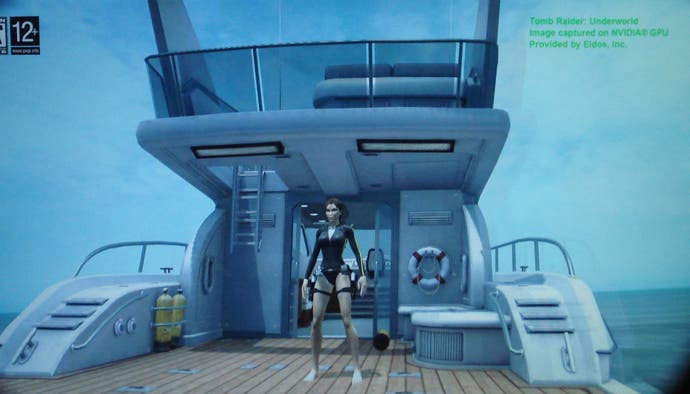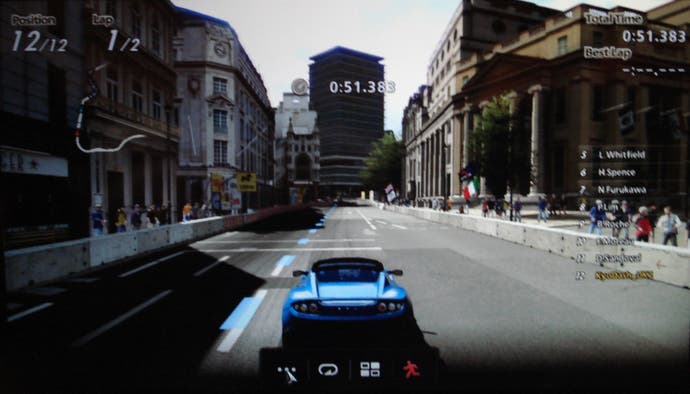Hardware Focus: Acer HN274H 3D Monitor
Meet the 27-inch screen that works with all 3D gaming formats.
3D Analysis
In terms of 3D performance, images on the Acer have a decent level of depth to them, despite this being held back slightly by the average black levels on offer. This is mostly down to the excellent nature of the display handling the stereoscopic effect: there are no obvious errors in how parallax - the different layers which make-up the depth - is displayed, and fast motion is also handled with aplomb - that is to say there is some judder present with 60FPS material, but the action remained smooth without massively reducing too much detail.
The 27-inch screen size is also perfect in terms of delivering an engrossing viewing experience when sitting just a few feet away: images easily fill your field of view helping to bring you closer to the action, while the fancy pop-out effects have a lot more impact.
The only real issue we have with the HN274H when viewing 3D content is with regards to crosstalk: it can be frequently visible with the double image effect being quite an eye-sore at times. This is something that is made worse when playing in 3D at 1080p, where the sharpness of the native resolution makes the artifacts far easier to spot. The effects of crosstalk are less visible when playing in lower resolutions as the additional blur of the upscaling helps in hiding the duplicate edges by making them softer - although this is something that doesn't apply to the PS3, where the gamma crush accentuates high contrast edges.
We also found the level of crosstalk to be largely dependent on the content being displayed on screen, and in our tests of several games we found it not to be an issue at all. For example, in Call Of Duty: Black Ops on the PC, the effects are barely apparent, except for a few mild instances, and we found the same thing to be true when playing GT5 on the PS3. However, both Killzone 3 and Dead Island (PC) demonstrated an excessive amount of crosstalk and double image ghosting that was very noticeable throughout. Lowering the contrast makes a big difference in reducing these artefacts, however in doing so you'll be sacrificing picture quality in other areas in order to do so.




That said, we were impressed by the HN274H's impressive support for 3D content over a wide range of sources, made possible by the inclusion of both a dual-link DVI input, and three HDMI 1.4 connectors, all of which are able to handle a multitude of resolutions and display modes for stereoscopic viewing. The inclusion of a HDMI interface that supports the 1.4 specification is perhaps the most important, as it potentially allows for games consoles and set-top boxes to take advantage of the monitors 3D capabilities, while also doubling up perfectly as a display for 2D sources - PAL resolution and refresh rates are supported for both 2D and 3D, which is great if you have a set-top box which outputs progressive scan.
However, there is one downside that limits the HN274H's use in this regard: you are restricted to either sequential 720p at 60Hz or 1080p 24Hz when using HDMI as the display is only partially compliant with the full 1.4 spec. Other 3D formats - such as side-by-side, top to bottom, reversed left or right etc - are only available by using a dual-link DVI cable. This won't be an issue for PC gamers, but when using the Xbox 360 or something like a Sky set-top box you'll need to purchase a separate HDMI to DVI adaptor or cable in order to take full advantage of the range of 3D viewing options available. Thankfully the Acer's DVI input supports HDCP, but the lack of full support for 3D modes over HDMI is puzzling to say the least.
Gaming and Input Lag
Latency can be something for a problem when it comes to gaming on flat panel displays. A number of elements can contribute to this, from the response time of the panel, to the amount of processing in play involved in delivering the final image to the screen. The result is a delay between button presses and the action on screen, reducing overall controller response and making the gameplay feel sluggish. For this reason, some of the sets which provide the best picture quality may not be very suitable for gaming.
For HDTVs with minimal lag, the ballpark result is usually between 20 to 35 milliseconds (ms), which is generally considered to be suitable for most gamers - arguably a display with less than 20ms latency shouldn't be a problem for anyone outside of professional or tournament players. As the HN274H uses a TN panel (rated at 5ms) and features minimal image processing, we should see numbers which are significantly lower than those quoted. Some of the most responsive PC monitors are able to deliver a gaming experience that comes very close to replicating that of a lag-free CRT - featuring around 0-8ms of lag when running in native resolution - thus allowing for highly responsive controller feedback in combination with the on-screen action.
We conducted our latency tests by displaying a time code simultaneously on both the HN274H and a lag free CRT from the same source, taking a range of photos in quick succession in order to show the differences between the time stamp on both - the only issue we encountered was that our CRT couldn't match the 1920x1080 resolution of Acer's panel. In total we measured under two frames of latency, but we would imagine that feeding a native signal would produce an even better response. Gaming feels extremely responsive on the Acer, with twitch-based titles and 60FPS releases - such as the Call of Duty series - really benefiting from such low levels of latency.
To be honest, we could barely feel a difference between the HN274H and our CRT, which is exactly what we'd hope to expect from a monitor designed specifically for gaming. Even heavily upscaled 480p games felt very responsive to play, far more so than on several HDTVs we tried. Although, given that there are competing displays out there with lower response times, we did expect that the results would be a little better for a flagship, top of the range (for Acer) product. Regardless, the majority of dedicated gamers will be more than happy with the level of responsiveness on offer.